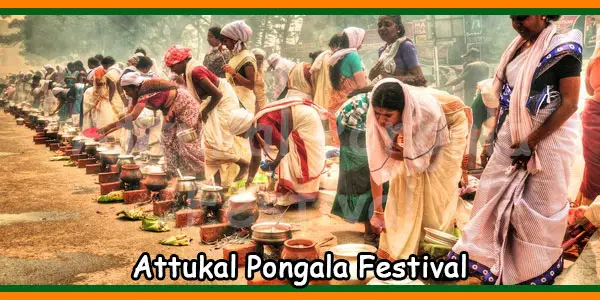Attukal Pongala is extremely popular and essentially women’s festival celebrated in ancient Bhagavathy temple Mudippura]. This temple is at Attukal in the Kaladi ward of the Thiruvananthapuram district, Kerala. The festival is a ten-day-long event. It begins from Bharani day [Karthika star] of the Malayalam month of Makaram-Kumbham [February-March]. The festival comes to an end with the sacrificial offering known as Kuruthitharpanam at night. Ninth day, biggest day of festival is celebrated and famous Attukal Pongala Mahotsavam is observed. Women of all castes and creed from Kerala and Tamil Nadu make offerings to the Goddess. They prepare pongala in the vicinity of the temple.
Significance of the Attukal Festival:
People believe that Goddess Attukalamma is the incarnation of ‘Kannaki’. She is the heroine of ‘Silappathikaram’ written by Tamil poet Illango in 2nd century A.D. Kannaki rested on her northward journey from Madurai to Kodungallur at Attukal.
‘Pongala’ means to boil over. It is the usual custom to make offering of things that please the Goddess Attukalamma. Offerings comprises of porridge of rice, sweet brown molasses, coconut gratings, nuts and raisins.

Celebrating Attukal Pongala:
Festivities begin with Thottampattu [a song about Bhagavathi]. These religious songs continue for nine days of the festival. On the ninth and the main day of Attukal Pongala, women gather in the temple. They have ingredients and materials for cooking Ponkala or Pongala. The ritual of cooking begins early in the morning so by noon, Pongala is ready. The Melsanthi [chief priest] arrives with the Devi’s sword. He blesses the women by sprinkling holy water and showering of flowers. The ‘blessed’ Pongala is taken home by the women.
Later, the idol of Devi is carried to Manacaud Sastha Temple in a colourful procession. This comprises of Thalapoli, Kuthiyottom, Annam, Vahanam, caparisoned elephants etc. Also, there is a musical ensemble made of famous artistes. On the route, the onlookers greet the procession with Nirapara. This is a measure filled with paddy and decorated with flowers. The procession reaches its destination the next morning marking the end of the festival.
Attukal Pongala History and Mythology:
A few centuries ago, the head of Mulluveettil family was met with a young girl who asked him to help her cross the Killi river in which he was performing his ritualistic prayers. The Karanavar (family head) knew it was no ordinary girl, because of her charm and charisma. He bowed before her and willingly took her to the other side of the river. He invited her to his home nearby and the whole family was preparing to receive this girl. However, they couldn’t find her as she had disappeared by the time Mulluveettil family was ready to receive her.
The Karanavar and his family were a little puzzled. The Karanavar saw the girl once again in his dream, in the same day as he saw the little girl. The girl appeared as an icon and told him to give her an abode in the nearby Kavu (a grove where shrubs and wild animals including snakes are left undisturbed). She told him that he would see three lines at a specific point in the kavu and she wanted her abode erected there.
With joy, the old man reached the Kavu and to his surprise, he found three lines marked on the ground. He knew it was a sacred spot and he wasted no time erecting a temple. The temple became the abode of the goddess, who later came to be known as Attukal Devi (Attukal Amma). Local devotees offered their prayers in this temple and soon the fame of this temple spread far and wide.
The people also offered to renovate the temple and a bigger temple with a new icon was installed. The goddess was represented as a woman with four arms, each bearing a spear, sword, skull and shield. The then high priest of Badarinath Temple led the consecration ceremony.
The girl that appeared before the Karanavar of Mulluveettil family is known to be Kannagi (Kannaki). Kannagi is the famous heroine of Chipathikaram, a Tamil epic written by Elenkovadikal. She is the incarnation of Sree Parvathy, the consort of Lord Siva. She took this incarnation of destroyer goddess, to destroy the evil and to preserve good. Kannagi was returning from Madurai, a city which she has destroyed, when she took a sojourn at Attukal and let the Karanavar see her as a little girl. She was on her way to Kodungalloor.
